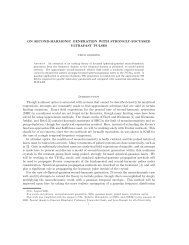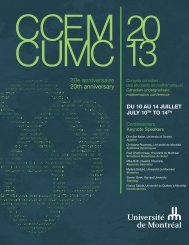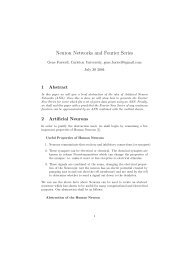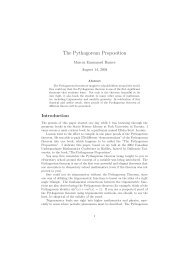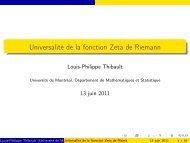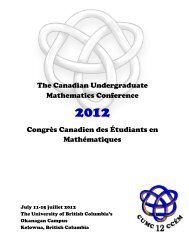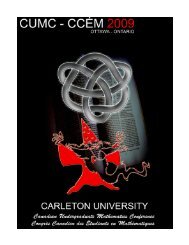booklet - CUMC - Canadian Mathematical Society
booklet - CUMC - Canadian Mathematical Society
booklet - CUMC - Canadian Mathematical Society
You also want an ePaper? Increase the reach of your titles
YUMPU automatically turns print PDFs into web optimized ePapers that Google loves.
FRACTALS, FINANCE AND THE FUTURE OF MARKETSOLIVIA SIMMONSThis talk will be based on the late Benoit Mandelbrot’s book The (Mis)Behavior ofMarkets: A Fractal View of Financial Turbulence. Originally published in 2004, Mandelbrotviews on financial markets were revolutionary and controversial, but now afterthe Global Credit Crunch of 2008 and Great Recession that followed, Mandelbrot’sideas are more relevant and applicable than ever. Benoit Mandelbrot discovered andcreated Fractal Geometry in the 1960’s, later applying the branch of Mathematics tomany disciplines including statistical physics, information technology, meteorology,cosmology, and of course economics among others. This is a general talk about thebasics of Fractals, a brief history and introduction to current financial markets, and theapplication of Fractals to market scaling. The great maverick Benoit B. Mandelbrot diedOctober 2010. Note to potential investors: This talk will not make you rich, but it willmake you wiser about the market and economics.TOPOLOGICAL GROUPSPATRICK DA SILVAA topological group is a topological space which is also a group in which multiplicationis a continuous map from G × G to G and the inverse map is a continuous mapfrom G to G. We shall use the group’s compatibility with the topology to deduce separabilityaxioms for the topology. Two fundamental facts about topological groups willbe explained ; a topological group is T 0 if and only if it is Hausdorff, and if it is not T 0 ,then we can quotient G by the closure of {1} (which will be seen to be a closed normalsubgroup) to obtain a T 0 space, hence an Hausdorff space, so that topological groupsare always one canonical quotient away from being Hausdorff.I will not use any fact from general topology, so feel free to come if you’ve only seenthe definition of a topology once in your life (if you’ve never seen it, go read it up andcome!).Required Background: Normal subgroups and quotient groups.AN INTRODUCTION TO LIE ALGEBRASPEGGY JANKOVICIt has been nearly 150 years since Sophus Lie pioneered the theory of continuoustransformation groups. Over that time, his influential work has crept into diversebranches of mathematics, including differential geometry, harmonic analysis, integralgeometry topology, combinatorics, number theory, finite group theory, mathematicalphysics, and quantum mechanics. In this talk, I will first introduce Lie algebras, examinetheir structure, and provide illustrative examples in SO(n). There will be a briefproof demonstrating the link between a Lie group and its Lie algebra. As well, therewill be an emphasis on the useful of a Lie algebra in capturing the properties of themore complicated Lie group. For the remainder of the presentation, I will focus onmy current research project on Lie superalgebras of type Q, including an overview ofsuperalgebras, Hecke-Clifford algebras, and a detour into category theory.Required Background: Vector spaces, preferably groups and modules also41



